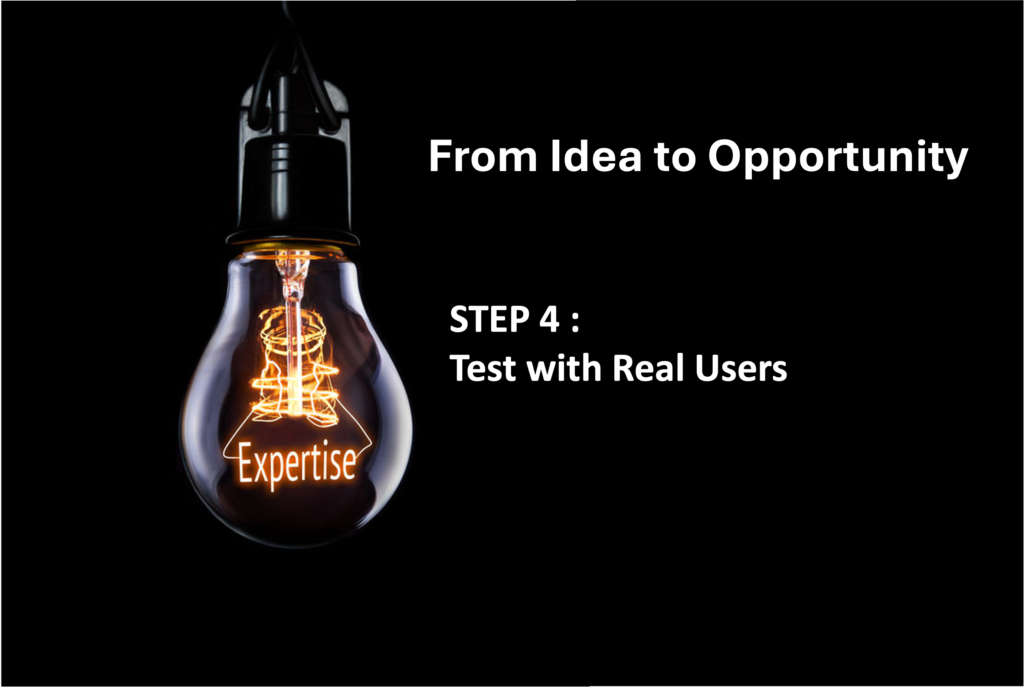
- Home
- Uncategorized
- From Idea to Opportunity Step 4: Test with Real Users
From Idea to Opportunity Step 4: Test with Real Users
After developing a Minimum Viable Product (MVP), the next critical step in validating your business idea is testing it with real users. This phase involves putting your MVP in the hands of actual customers who can provide feedback based on their experience. This feedback is invaluable as it shapes the future iterations of your product, ensuring it better meets the needs of your
target market. Here’s a detailed breakdown of how to effectively test your MVP with real users.
Importance of Testing with Real Users
- Validate Product-Market Fit: Testing with real users helps confirm whether there is a genuine demand for your product and if it solves the problem it’s intended to.
- Gather Insightful Feedback: Direct feedback from users can provide insights into what works, what doesn’t, and what features might be necessary to add.
- Improve User Experience: Understanding how real users interact with your product allows you to make necessary adjustments to improve usability and the overall user experience.
- Reduce Long-Term Costs: Early testing can help catch issues before they become costly to fix in terms of both money and brand reputation.
Steps to Test with Real Users
Link :
How to Enhance Your MVP with Real User Feedback
21 Solid Ways to Validate your Minimum Viable Product
Step 1: Select Your Test Group
- What to Do: Choose a group of users that accurately represents your target audience. This group should consist of people who are most likely to use your product in real scenarios.
- How to Apply: Use demographic information and user personas to select participants. Consider leveraging existing customer databases, social media channels, or services like UserTesting.com to recruit test users.
Step 2: Define Success Criteria
- What to Do: Establish clear, measurable goals for what success looks like in this testing phase. These might include usability, satisfaction rates, or specific task completion rates.
- How to Apply: Set metrics such as Net Promoter Score (NPS), completion of key actions within the app, or direct user ratings of their experience.
Step 3: Conduct the Testing
- What to Do: Implement a structured process for users to interact with your MVP. This can be done through beta testing, controlled releases, or pilot programs.
- How to Apply: Create scenarios or tasks that users should try to complete. Observe and record their interactions. Tools like Lookback.io or Hotjar can be used for recording sessions and gathering direct feedback.
Step 4: Collect and Analyze Feedback
- What to Do: Gather feedback through surveys, interviews, and observation notes. Pay special attention to recurrent themes or consistent issues that users report.
- How to Apply: Use survey tools like SurveyMonkey or Google Forms for quantitative data, and conduct in-depth interviews for qualitative insights.
Step 5: Iterate Based on Insights
- What to Do: Apply the insights gathered from user testing to refine your product. Prioritize changes that align with your core objectives and user needs.
- How to Apply: Adjust features, design, and user flows based on feedback. If necessary, conduct multiple rounds of testing to validate changes and improvements.
Tools for Effective User Testing
- Analytics Tools: Google Analytics, Mixpanel, and Amplitude can track how users interact with your product and identify where they encounter issues.
- Survey Tools: Tools like Typeform and SurveyMonkey can collect user feedback efficiently.
- Session Recording Tools: Use services like FullStory or Hotjar to capture user interaction within your product in real-time.
Testing your MVP with real users is not just about finding out if people like your product, but about understanding how they use it, what challenges they face, and how it fits into their daily lives. This stage is critical for refining your product to ensure it not only meets but exceeds market expectations. By effectively analyzing user feedback and applying insights to your product development, you can enhance your chances of success in the competitive market landscape
- Step 1: Define Your Core Hypothesis
- Step 2: Conduct Market Research
- Step 3: Build a Minimum Viable Product (MVP)
+ There are no comments
Add yours